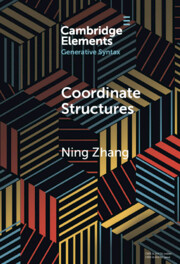Refine search
Actions for selected content:
33 results
Chapter 13 - Reductive Realism
- from Part V - Categories
-
-
- Book:
- Suárez's <i>Metaphysical Disputations</i>
- Published online:
- 13 October 2025
- Print publication:
- 30 October 2025, pp 241-256
-
- Chapter
- Export citation
7 - Polynomial comonoids and retrofunctors
- from Part II - A different category of categories
-
- Book:
- Polynomial Functors
- Published online:
- 27 September 2025
- Print publication:
- 16 October 2025, pp 295-376
-
- Chapter
- Export citation

Polynomial Functors
- A Mathematical Theory of Interaction
-
- Published online:
- 27 September 2025
- Print publication:
- 16 October 2025
6 - Gnosticism
- from Part II - Case Studies
-
-
- Book:
- The Cambridge Companion to Christian Heresy
- Published online:
- 17 July 2025
- Print publication:
- 31 July 2025, pp 115-135
-
- Chapter
- Export citation
Appendix A - A Catalogue of 2-Polygraphs
- from Appendices
-
- Book:
- Polygraphs: From Rewriting to Higher Categories
- Published online:
- 18 March 2025
- Print publication:
- 03 April 2025, pp 477-497
-
- Chapter
- Export citation
2 - Grouping
-
- Book:
- Stress and Accent
- Published online:
- 15 March 2025
- Print publication:
- 27 March 2025, pp 34-65
-
- Chapter
- Export citation
2-CATEGORICAL FAM CONSTRUCTIONS
-
- Journal:
- Bulletin of the Australian Mathematical Society / Volume 111 / Issue 2 / April 2025
- Published online by Cambridge University Press:
- 10 January 2025, p. 379
- Print publication:
- April 2025
-
- Article
-
- You have access
- HTML
- Export citation
When more is less: the impact of multimorphemic words on learning word meaning
-
- Journal:
- Language and Cognition / Volume 16 / Issue 4 / December 2024
- Published online by Cambridge University Press:
- 07 October 2024, pp. 1852-1880
-
- Article
-
- You have access
- Open access
- HTML
- Export citation

Coordinate Structures
-
- Published online:
- 21 November 2023
- Print publication:
- 14 December 2023
-
- Element
- Export citation
2 - Cassirer’s Transformation of the Critique of Reason into a Critique of Culture
- from Part I - The Lasting Meaning of Kant’s Thought
-
- Book:
- Cassirer and Heidegger in Davos
- Published online:
- 05 May 2022
- Print publication:
- 19 May 2022, pp 47-61
-
- Chapter
- Export citation
2 - Overview of the Book
-
- Book:
- A Student's Introduction to English Grammar
- Published online:
- 20 January 2022
- Print publication:
- 25 November 2021, pp 20-41
-
- Chapter
- Export citation
2 - Theory
-
- Book:
- Revolution in Syria
- Published online:
- 18 June 2021
- Print publication:
- 08 July 2021, pp 23-59
-
- Chapter
- Export citation
3 - Networks, Identities, and Patronage in Contemporary Syria
-
- Book:
- Revolution in Syria
- Published online:
- 18 June 2021
- Print publication:
- 08 July 2021, pp 60-93
-
- Chapter
- Export citation
2 - A Refresher of Topology and Ordinal Numbers
-
- Book:
- Counterexamples in Measure and Integration
- Published online:
- 27 May 2021
- Print publication:
- 17 June 2021, pp 36-54
-
- Chapter
- Export citation
Chapter 4 - Phonetic and Phonological Influences on the Discrimination of Non-native Phones
- from Part I - Theoretical Progress
-
-
- Book:
- Second Language Speech Learning
- Published online:
- 21 January 2021
- Print publication:
- 04 February 2021, pp 157-174
-
- Chapter
- Export citation
Old age as a new class or an outdated social category? Objective and symbolic representations of later life
-
- Journal:
- Ageing & Society / Volume 42 / Issue 7 / July 2022
- Published online by Cambridge University Press:
- 09 November 2020, pp. 1499-1512
- Print publication:
- July 2022
-
- Article
- Export citation
1 - “I Speak, Therefore I Am”
- from Part I - The Power of Symbolic Representation
-
- Book:
- Language as Symbolic Power
- Published online:
- 15 October 2020
- Print publication:
- 29 October 2020, pp 19-37
-
- Chapter
- Export citation
Dimensions over categories: a meta-analysis of taxometric research
-
- Journal:
- Psychological Medicine / Volume 50 / Issue 9 / July 2020
- Published online by Cambridge University Press:
- 04 June 2020, pp. 1418-1432
-
- Article
- Export citation
1 - Basic Facts on Categories
-
- Book:
- Derived Categories
- Published online:
- 15 November 2019
- Print publication:
- 19 December 2019, pp 26-36
-
- Chapter
- Export citation
The Category of Ordered Bratteli Diagrams
- Part of
-
- Journal:
- Canadian Journal of Mathematics / Volume 73 / Issue 1 / February 2021
- Published online by Cambridge University Press:
- 03 September 2019, pp. 1-28
- Print publication:
- February 2021
-
- Article
- Export citation
